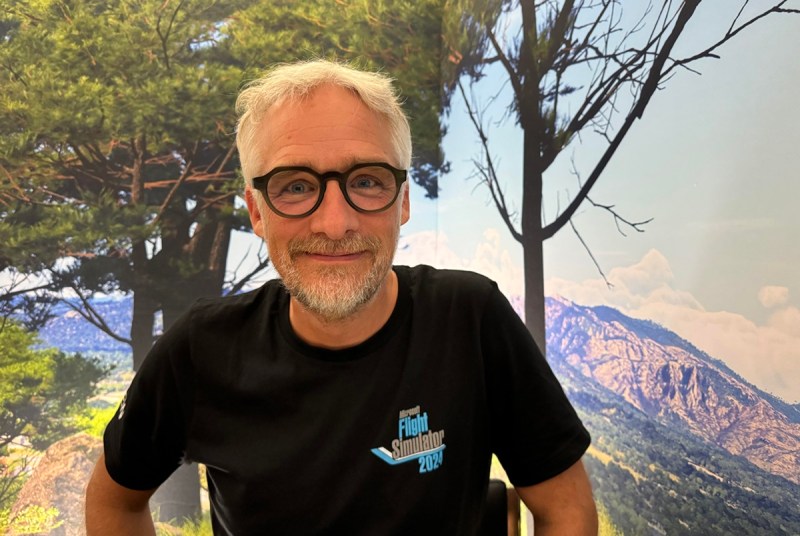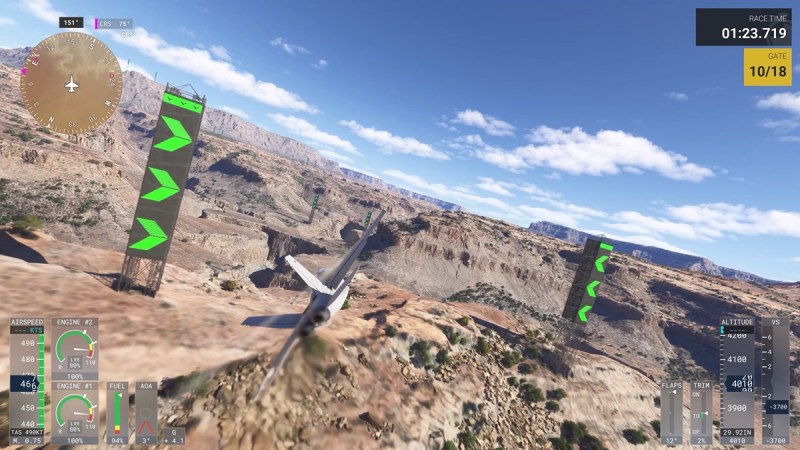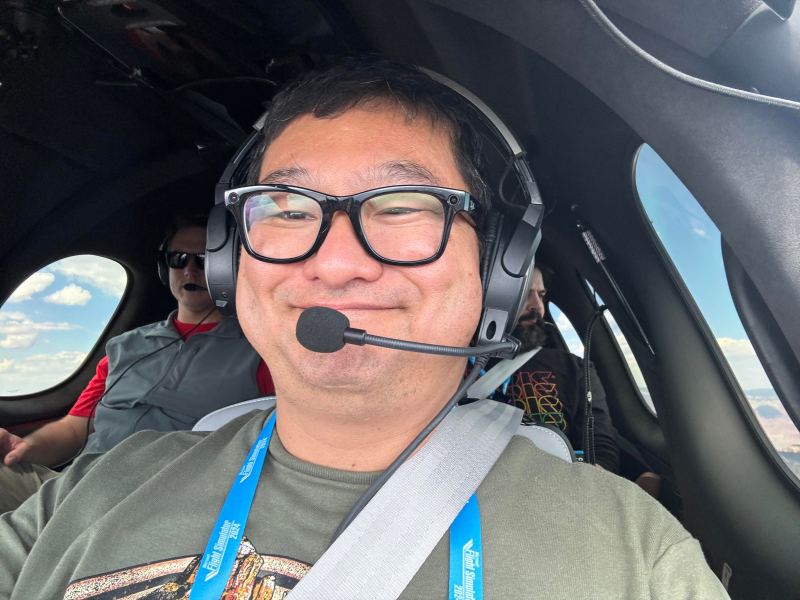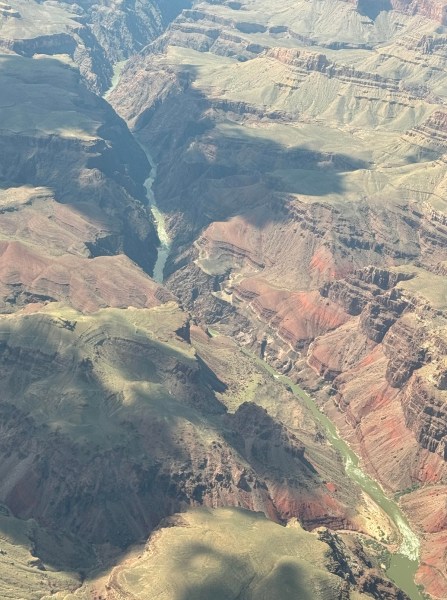For Microsoft Flight Simulator 2024, this is a reasonable question. Is it a game, a simulation or reality?
On the reality side, the previous version in 2020 was played by 15 million people, and it spurred a desire for flight that is much needed in our modern society. Since we’re all flying around the globe so much, there’s a shortage of around 800,000 pilots.
The simulation is also so detailed — with 4,000 times more ground detail than the original game, that it has to be computed in Microsoft’s Azure cloud, which consists of a global network of data centers that can computer the game and its imagery and send it down in real time to each player’s PC or game console so that they may not realize that it wasn’t computed on their home machine.
It’s funny that one of the development leaders — David Dedeine, creative director — told me that when he flew over the Grand Canyon in real life, he finally realized his art director was right. In building the game, Wloch thought there was too much greenery around the desert-like canyon. Above the canyon, he realized that it was surrounded by forests and had trees growing out of cliffs with greenery aplenty. That means that the data that the company had collected from its real-life data sources like satellites, flight cameras and more — all of that was right.
Join us for GamesBeat Next!
GamesBeat Next is almost here! GB Next is the premier event for product leaders and leadership in the gaming industry. Coming up October 28th and 29th, join fellow leaders and amazing speakers like Matthew Bromberg (CEO Unity), Amy Hennig (Co-President of New Media Skydance Games), Laura Naviaux Sturr (GM Operations Amazon Games), Amir Satvat (Business Development Director Tencent), and so many others. See the full speaker list and register here.
And on the game side, there’s a recognition that just flying a plane — and not really fighting a war with it like in many video games — can be boring and not so fun. So the team stayed busy creating three million challenges for players to play in the game so they could be excited about the product. One of the cool things for me: flying through virtual green gates in a kind of slalom course through the Grand Canyon in a F/A-18e Super Hornet fighter jet. That’s something you can’t do in real life.
I recently joined the Microsoft Flight Simulator 2024 leaders at a briefing at the Grand Canyon, where we flew a jet and played a preview of the game, which comes out on November 19, 2024.
As part of the presentation. I was paired with game journalist Samuel Stone of Den of Geeks for an interview with Dedeine, who is creative director on the game at Asobo Studio.
His team was a big part of something like 800 people who worked on the project over as much as four years.
Here’s an edited transcript of our interview.

GamesBeat: What’s the connection between the real world and the game when it comes to the Grand Canyon? What do you notice in the game that you’ve seen here?
David Dedeine: I have a good story about that. I came here when I was 17 years old, with my parents. My memory is that it was super dry. When we were preparing the event, I was talking with the art director. I was staying in the area. His name is Patrice. “Patrice, there’s something wrong. It’s way too green here. My memory is that it’s much drier.” Patrice heard that feedback and came back to me. “No, David, I think it’s fine. It’s what it needs to be.” When we flew here with Sebastian, we looked at the environment and said, “My God.”
What I like about this story is that it shows you that how we build the game is data-driven. Species are able to grow at a specific altitude and latitude in a specific type of soil. We’re helped by all the data that helps us populate the world. But the thing is, from the sky you look down and you can’t always tell if something is just a bush or an entire tree. I was surprised to–when we flew this morning, we saw that the forest grows very close to the rim. It’s exactly like it is in the game.
GamesBeat: There are a lot of trees, and the trees are very green. But in between them there’s so much rock. It seems strange, having all the green trees against the desert rock.
Dedeine: That’s why I love this story. The systemic nature of how we build the world sometimes prevents us from creating an environment that’s influenced by our intellectual bias. “Oh my God, I was wrong. I was so wrong.” To be honest, from the sky I’ve also observed that some areas are very dry, with no vegetation. That’s also true.
Samuel Stone: One of the things that’s most ambitious about 2024 is the inclusion of all these activities. The challenge modes, the career mode. How does it strike a balance between authenticity and attention to detail while trying to avoid gamifying the experience too much?
Dedeine: One of the mantras we always use to analyze a situation, we’re working on Flight Simulator. That’s in the title. It’s a sim. As I hope you’ve observed, even in what we would consider the most game-ey part of the experience you played today, the F-18 is the same F-18 you’d use in free flight. It’s not that the experience of flying is gamified. The goal is to match the expectations of the community all over the world, what they want.

Jorg talked about this a bit. Stepping back further, even before we launched 2020, we were already thinking about the career system, the activities and so on. We were super excited. But the reality is that in order to make 2020 good, we had to shelve those developments and focus on other things.
When we launched 2020, we did several surveys post-launch. In each of those surveys, whatever type of profile–what I mean by this is gamers, hardcore sim players, digital tourists. Even sometimes people who never played video games. All across the board, the number one thing everyone wanted was more goals. They wanted purpose. We knew we needed to go for it and do the career.
Then the question was, what type of goals, and for who? We’re all of these people sometimes. I like to say that we don’t eat the same dish every single day. Sometimes you want Thai food. Even on the same day you might evolve, or even the same session. You might start by playing something very hardcore, but you’re happy to leave the session with a bit of something fun, something action.
As long as what is required as a skill in order to perform in a game activity is true to life–if it gives you a way to engage with the sim that fits your mood of the day, or the type of player you are, I think everyone is happy. We believed that was going to be the case because that’s what people were asking for. If you think about it, what’s cool about the challenges, for example, even if you’re scared of the complexity of the aircraft and you just want to enjoy the feeling of flying, or if you don’t have a lot of time, or if you’re feeling in a competitive mode, you can do the challenges. You’ll soon realize that there’s no ceiling to the performance. It’s an actual plane. The better you get at it, the better every single meter of altitude can be transformed into energy and speed. You can convert that into better times.
I don’t believe what when we’re doing challenges, which is clearly the most elaborate–it basically checks all the boxes. It’s short. It’s fast. It’s stackable. It’s competitive. It sounds like the perfect gaming mode. But simmers like it. Flight sims aren’t only one thing. It’s just an entry point.

GamesBeat: I had a question related to simmers. Do they care whether the water in the Grand Canyon is green or blue? If they want blue, and it’s actually really green when you look at it from above, what do you do?
Dedeine: They should know that it really depends–it’s a complex question. You know Bordeaux, in France? It’s very close to the sea. What’s funny is that the river there can go both ways as well, because of the tide and the rain. The Gironde river can turn a very brown color. But during the summer, if there’s not too much rain, and the ocean is pushing up into the river, pushing back the flow, it will look green. Even on a single day those kinds of things can change color. At the moment there’s no way we can fix that. Maybe one day. But that’s another plan.
What you probably refer to is how the satellite data we used to do the Grand Canyon–maybe it was a rainy day. A lot of mud was washed into the river and turned it brown. But the day you flew over it, it wasn’t that rainy, and so it was green. That’s just the way it is.
Stone: You mentioned 2020. That was the first Flight Sim to release for the Xbox Series X|S. Taking three years worth of feedback and refining the console version, what is it like when mapping and translating the 2024 experience to the Xbox?
Dedeine: It’s complex. Mapping is very important. I can give an example. I’ll talk about a specific feature. As you’ve observed, in the career, there’s the action button. The “do everything” button. It doesn’t mean that suddenly you can’t do something by yourself, looking at the actual instruments, if you want. But if you don’t want to engage with that–let me step back. What’s frustrating is that sometimes real life is easier than what you experience in the game. When you’re in front of the cockpit and you want to set the parking brake, it’s simple. It’s natural. It’s actually harder in a game. If you need to be a pianist to be able to do it, that’s a big issue.
That’s the reason why we came up with this sort of simplification for the mapping, in order to give people the opportunity to just push one button. That’s as simple as it would be in real life. It’s the same spot on the pad. In real life it might be a little different, but it better reflects how difficult it really is. I hate it when a game interface makes doing something harder than it would be in reality. We’ll continue to try to improve this.
This morning, when we were preparing for the day, we knew we needed to have game pads, game controllers. The previous day, the audience was made up of simmers. They were used to doing their own configuration. They don’t need us to help them find their way when it’s complicated. Sometimes having an objective like “Push these buttons to talk to ATC,” it’s just not fun. It becomes much harder than it is in real life. These simplifications make the pad experience closer to reality. It was something we improved.
It sounds simple presented like that, but making it work whatever the context, whatever the device, whatever the mission, but–I’ll give another example. It’s easy to say, “This button does everything.” But sometimes it’s several steps. In firefighting, you need to open the doors to pick up water. There are several levers involved in that. It informs how much we’re going to slow you down. What do we do in this case? We have just one button. We can’t suddenly say, “We need two for this thing.” That misses the point. In lots of those cases we need to find a compromise. The devil is in the details sometimes. It’s always hard until it becomes simple.

GamesBeat: What systems really matter? The example of herding the sheep with the helicopter, how many systems have to be built in order to make that happen? Is that payoff worth it? Do you think about it that way? “The payoff here is that it’s a lot of fun to herd sheep with a helicopter, so what can we do to make that happen?”
Dedeine: Technically, it’s not as hard as it might sound. It’s much harder to spawn the animals in the appropriate spots all over the planet and keep a good framerate and good memory management and so on. That’s complicated. But as soon as you’ve done that successfully, making animals flee when you get close to them–the reason why Jorg talks about this is because in the future, we hope to do a dedicated activity around this. It’s quite common in Australia, being this sort of flying cowboy. You collect a huge herd and push them into the next field. It’s something we may do in the future, but it requires other systems we don’t have yet. We have many other things to do.
That said, if you have an animal in the game, and if you fly up to it and it doesn’t react, that’s not believable. The minimum viable behavior we needed was, when you fly close to an animal, it at least needs to flee from you. That’s what we have right now. If you take a helicopter close to a herd of kangaroos, they’ll flee. But can we really do that kind of mustering yet? No.
Stone: Given the real time data around weather and environment, given the multitude and magnitude of geographic locations–I think you mentioned more than 3 million different kinds of activities. That’s a lot. How do you come up with that, presenting that breadth of gameplay?
Dedeine: There are many ways to talk about that. We’ve observed that some people, simmers or not, love to stay in one area. They’ll spend their whole life flying in Corsica, for example. We knew from the beginning that we needed to address that. We needed to address the fact that people might stay hyper-local. They’d be happy to navigate the career to perhaps the best level possible, to create their own company, but they’ll just fly in Corsica. Whatever the reason, that’s the way they like it. But there are also people who want to go everywhere on the planet.

In order to deliver all of these fantasies–plus, you add the fact that we update those missions every day. That’s how you get this number. We needed this. Another side of the answer, it’s easy to take a database and trace a line between two points. A million, even a billion, that’s easy. So it’s not just about the number. It’s about the quality.
To give you an example, if you want to make a believable scenario where you have to transport someone who’s just broken his leg on a ski slope in the winter in the Alps, bringing this guy to the closest hospital, you need a lot of different conditions. You need a ski area. You need a runway that’s close to the ski area, to justify the fact that you’re using a plane. Otherwise they’d go by car. Depending on the level of difficulty–maybe we want to make a mission that takes 20 minutes. You need to find an airport close to a town with a big hospital, to explain why you would fly there. With all those rules and constraints, you come up with a series of candidates that support the narrative scenario. But also, you need to take into account which plane is involved. Maybe the runway is super short. It’s hard to land there if your plane is too big. And so on and so on.
That’s why it’s not only about generating tons of missions. That’s easy. It’s generating missions that match the narrative aspect, but also expose the highlights, the very specific aspects of the activity you’re doing. Search and rescue with a plane–it’s funny to observe how that can become ridiculous if you start to do it too close to a city. There’s no way this guy could have gotten lost here! There’s no way you’d need an airplane to search here. You need to find a place where no cars could go, where there are no big structures. But you also need to find a place where you can land, a surface that’s large enough, long enough, and flat enough. Otherwise you can’t complete the mission.
The good news is that even with all those constraints, we came up with 3 million missions. But it’s a huge amount of filtering we have to apply to the millions or billions of possible missions. Applying those constraints when we come back with the best possible scenarios for each type of activity.
READ SOURCE








